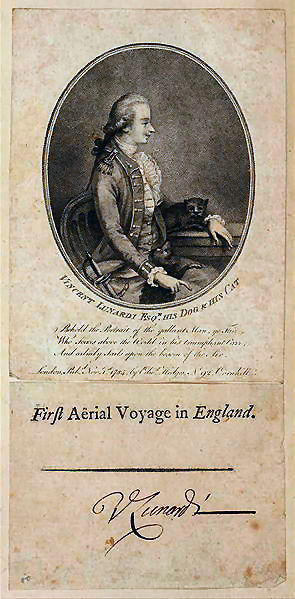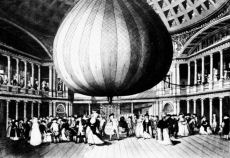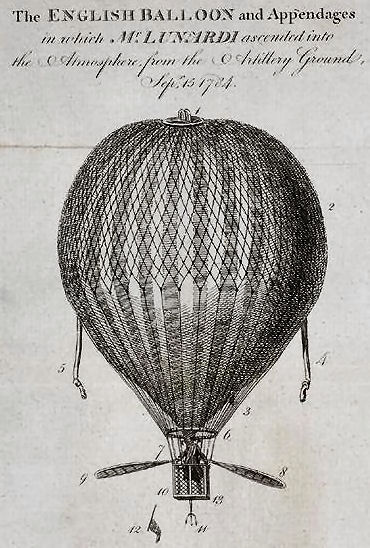 |
Image from: Wikimedia Commons |
The English historian of aerostation gives some details of the first aerial voyage made in this country by the Italian, Vincent Lunardi.
The balloon was made of silk covered with a varnish of oil, and painted in alternate stripes--blue and red. It was three feet in diameter. Cords fixed upon it hung down and were attached to a hoop at the bottom, from which a gallery was suspended. This balloon had no safety-valve--its neck was the only opening by which the hydrogen gas was introduced, and by which it was allowed to escape.
In September, 1784, it was carried to the Artillery Ground and
filled with gas. After being two-thirds filled, the gallery was
attached with its two oars or wings, and Lunardi, accompanied by
Biggin and Madame Sage, took his place; but it was found that the
balloon had not sufficient lifting power to carry up the whole three, and Lunardi went up alone, with the exception of the
pigeon, the cat, and the dog, that were with him.The balloon rose to the height of about twenty feet, then
followed a horizontal line, and descended. But the gallery had
no sooner touched the earth than Lunardi threw over the sand that
served as ballast, and mounted triumphantly, amid the applause of
a considerable multitude of spectators.
 |
Vincenzo Lunardi's balloon exhibited at the Pantheon in Oxford Street, London circa 1783.
Image from: Wikimedia Commons |
After a time he
descended upon a common, where he left the cat nearly dead with
cold, ascended, and continued his voyage. He says, in the
narrative which he has left, that he descended by means of the
one oar which was left to him, the other having fallen over; but,
as he states that, in order to rise again, he threw over the
remainder of his ballast, it is natural to believe that the
descent of the balloon was caused by the loss of gas, because, if
he descended by the use of the oar, he must have re-ascended when
he stopped using it. He landed in the parish of Standon, where
he was assisted by the peasants.
He assures us again that he came down the second time by means of
the oar. He says:--"I took my oar to descend, and in from
fifteen to twenty minutes I arrived at the earth after much
fatigue, my strength being nearly exhausted. My chief desire was
to escape a shock on reaching the earth, and fortune favoured
me." The fear of a concussion seems to indicate that he
descended more because of the weight of the balloon than by the
action of the oar.
 |
A newspaper reference of Lunardi's flight in August 1786 from York Races to Kilnwick near Pocklington. From: Morning Chronicle and London Advertiser (London, England), Tuesday, August 29, 1786 |
It appears that the only scientific instrument he had was a
thermometer which fell to 29 degrees. The drops of water which
had attached themselves to the balloon were frozen. The second aerial journey in England was undertaken by Blanchard
and Sheldon. The latter, a professor of anatomy in the Royal Academy, is the first Englishman who ever went up in a balloon.
This ascent was made from Chelsea on the 16th October, 1784.
The same balloon which Blanchard had used in France served him on
this occasion, with the difference that. the hoop which went
round the middle of it, and the parasol above the car, were
dispensed with. At the extremity of his car he had fitted a sort
of ventilator, which he was able to move about by means of a
winch. This ventilator, together with the wings and the helm,
were to serve especially the purpose of steering at will, which
he had often said was quite practicable as soon as a certain
elevation had been reached.
The two aeronauts ascended, haying with them a number of
scientific and musical instruments, some refreshments, ballast, &c. Twice the ascent failed, and eventually Sheldon got out, and
Blanchard went up again alone.
Blanchard says that, on this second ascent, he was carried first
north-east, then east-south-east of Sunbury in Middlesex. He
rose so high that he had great difficulty in breathing, the
pigeon he had with him escaped, but could hardly maintain itself
in the rarefied air of such an elevated region, and finding no place to rest, came back and perched on the side of the car.
After a time, the cold becoming excessive, Blanchard descended
until he could distinguish men on the earth, and hear their
shouting. After many vicissitudes he landed upon a plain in
Hampshire, about seventy-five miles from the point of departure.
It was observed that, so long as he could be clearly seen, he
executed none of the feats with his wings, ventilator, &c., which
he had promised to exhibit.
Enthusiasm about aerial voyages was now at its climax; the most
wonderful deeds were spoken of as commonplace, and the word "impossible" was erased from the language. Emboldened by his
success, Blanchard one day announced in the newspapers that he
would cross from England to France in a balloon--a marvellous
journey, the success of which depended altogether upon the course
of the wind, to the mercy of which the bold aeronaut committed
himself.
 A certain Dr. Jeffries offered to accompany Blanchard. On the
7th of January the sky was calm, in consequence of a strong frost
during the preceding night, the wind which was very light, being
from the north-north-west. The arranged meets were made above
the cliffs of Dover. When the balloon rose, there were only A certain Dr. Jeffries offered to accompany Blanchard. On the
7th of January the sky was calm, in consequence of a strong frost
during the preceding night, the wind which was very light, being
from the north-north-west. The arranged meets were made above
the cliffs of Dover. When the balloon rose, there were only
three sacks of sand of 10 lbs. each in it. They had not been
long above ground when the barometer sank from 29.7 to 27.3. Dr.
Jeffries, in a letter addressed to the president of the Royal
Society, describes with enthusiasm the spectacle spread out
before him: the broad country lying behind Dover, sown with
numerous towns and villages, formed a charming view; while the
rocks on the other side, against which the waves dashed, offered
a prospect that was rather trying.
They had already passed one-third of the distance across the
Channel when the balloon descended for the second time, and they
threw over the last of their ballast ; and that not sufficing,
they threw over some books, and found themselves rising again.
After having got more than half way, they found to their dismay,
from the rising of the barometer, that they were again
descending, and the remainder of their books were thrown over.
At twenty-five minutes past two o'clock they had passed
three-quarters of their journey, and they perceived ahead the
inviting coasts of France. But, in consequence either of the
loss or the condensation of the inflammable gas, they found
themselves once more descending. They then threw over their
provisions, the wings of the car, and other objects. "We were
obliged," says Jeffries, "to throw out the only bottle we had,
which fell on the water with a loud sound, and sent up spray like
smoke."
They were now near the water themselves, and certain death seemed
to stare them in the face. It is said that at this critical
moment Jeffries offered to throw himself into the sea, in order
to save the life of his companion.
"We are lost, both of us," said he; "and if you believe that it
will save you to be lightened of my weight, I am willing to
sacrifice my life."
This story has certainly the appearance of romance, and belief in
it is not positively demanded.One desperate resource only remained--they could detach the car
and hang on themselves to the ropes of the balloon. They were
preparing to carry out this idea, when they imagined they felt
themselves beginning to ascend again. It was indeed so. The
balloon mounted once more; they were only four miles from the
coast of France, and their progress through the air was rapid.
All fear was now banished. Their exciting situation, and the
idea that they were the first who had ever traversed the Channel
in such a manner, rendered them careless about the want of
certain articles of dress which they had discarded. At three
o'clock they passed over the shore half-way between Cape Blanc
and Calais. Then the balloon, rising rapidly, described a great
arc, and they found themselves at a greater elevation than at any
part of their course. The wind increased in strength, and
changed a little in its direction. Having descended to the tops
of the trees of the forest of Guines, Dr. Jeffries seized a
branch, and by this means arrested their advance. The valve was
then opened, the gas rushed out, and the aeronauts safely reached
the ground after the successful accomplishment of this daring and memorable enterprise.
A number of horsemen, who had watched the recent course of the
balloon, now rode up, and gave the adventurers the most cordial
reception. On the following day a splendid fete was celebrated
in their honour at Calais. Blanchard -was presented with the
freedom of the city in a box of gold, and the municipal body
purchased the balloon, with the intention of placing it in one of
the churches as a memorial of this experiment, it being also
resolved to erect a marble monument on the spot where the famous
aeronauts landed.
Some days afterwards Blanchard was summoned before the king, who
conferred upon him an annual pension of 1,200 livres. The queen,
who was at play at the gambling table, placed a sum for him upon
a card, and presented him with the purse which she won.
|

